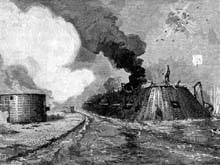
The Ericsson Ironclad Battery Monitor as illustrated in Harper's Weekly, March 22, 1862. (Monitor Collection, NOAA) Click image for larger view.
History
A First in Naval Architecture
At the outbreak of the American Civil War, naval technology was improving rapidly, with both armament and armor reaching new levels of effectiveness. The USS Monitor was rushed into production to meet the threat of the larger and more heavily armed Confederate ironclad Virginia.
Designed by Swedish-American engineer John Ericsson, the Monitor represented a radical departure from traditional warship design. The vessel was powered by steam alone and was the first American warship with no masts and sails. With barely more than one foot of her deck visible, all machinery, storage, working and berthing areas were below the water line. The vessel was constructed almost exclusively of iron and was heavily armored. A 5-foot high, 6-inch thick armor belt encircled the vessel at the water line for protection during battle. Perhaps the ship's most novel feature was its revolving turret. Located near the middle of the ship, it was 9 feet high, 22 feet in diameter, and housed two 11-inch Dahlgren smoothbore cannon.
An artist's rendering of the launch of the USS Monitor at the Continental Iron Works at Greenpoint, NY, as illustrated in Harper's Weekly, September 1862. (Monitor Collection, NOAA) Click image for larger view.
The Battle of the Ironclad
The Monitor was launched from Continental Iron Works, Greenpoint, Long Island (New York City) on January 30, 1862. The CSS Virginia, a Confederate ironclad, was launched February 17, 1862. The Virginia was constructed over the modified hull of the steam frigate USS Merrimack, which theConfederates had salvaged after she was burned and scuttled by Union forces. Because of the threat that the Virginia posed to the Federal fleet at Hampton Roads, Virginia, the Monitor was ordered to that area in early March, immediately following hurried sea trials. She arrived at Hampton Roads the night of March 8. Earlier that day, the Virginia had engaged the Federal fleet, destroying the wooden frigates Cumberland and Congress. The Minnesota had also been damaged and stranded before the Virginia retired to sheltered anchorage near Norfolk.
When the Virginia steamed out to renew the attack on the Minnesota early on the morning of March 9, she encountered the strange-looking Monitor. In the ensuing four-hour battle, the two vessels frequently bombarded each other at point-blank range with no substantial effect. However, a shell exploded in the viewport of the Monitor's pilothouse, temporarily blinding Captain John Worden. The Monitor's Executive Officer, Samuel Dana Greene, assumed command and ordered the Monitor into shallow water, where the Virginia could not follow, to assess the captain's wounds and damage to the ship. The Virginia's captain, assuming that the Monitor was withdrawing from battle, also withdrew in supposed victory. When the Monitor returned to resume the engagement and found the Virginia gone, her crew also assumed victory.

Sailors from the USS Rhode Island rescuing the crew of the sinking Monitor as illustrated in Harper's Weekly, January 1863 (colorized version). (Monitor Collection, NOAA) Click image for larger view.
A Draw
In reality, the battle was a virtual draw with neither vessel inflicting serious damage on the other. The Monitor was successful in protecting the stranded Minnesota, while the Virginia prevented the Monitor from advancing up the James River toward Richmond, the Confederate capital. Although the Monitor remained in the Hampton Roads area for most of the spring and summer of 1862, the two vessels never again met in battle. In May of that year, trapped between advancing Union forces and the sand bar at the mouth of the James River, the Virginia was destroyed by her crew to prevent her capture.
Lost at Sea
With the exception of her famous engagement with the Virginia, the Monitor'brief career was uneventful. Shortly after midnight on December 31, 1862, while under tow by the USS Rhode Island to Beaufort, North Carolina, the Monitor sank in a gale off Cape Hatteras, North Carolina. The event was described in detail by the Monitor's paymaster, William Keeler, in letters to his wife, Anna. Keeler described the mounting fear of the officers and crew as the vessel took on water and waves broke over the top of the turret, completely submerging the deck. Water poured in around the turret faster than the pumps could remove it. Reluctantly, the captain gave the order to abandon ship. Sixteen crewmen lost their lives. Two were lost while attempting to cut the tow line to the Rhode Island, and others were swept overboard while attempting to reach the lifeboats; it is not known how many went down with the ship.
The Monitor was lost at sea less than a year after her launch. However, her battle with the CSS Virginia at Hampton Roads impressed ship designers and naval personnel around the world, and heavily influenced future warship designs. The U.S. Navy built more than 60 "monitor-type" vessels during the Civil War, and similar ships were built in other countries. Few, if any, ships have had such a profound effect on naval architecture and technology as the USS Monitor, the vessel known as "the little cheesebox-on-a-raft."
Sign up for the Ocean Explorer E-mail Update List.






















